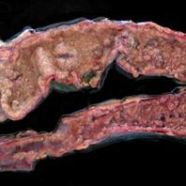Poultry killing toxin falsely accused

Necrotic enteritis, the gut disease in chickens, costs the global poultry industry about US$2 billion a year; however, are we misled about what causes the disease?
Anthony Keyburn at Australia’s Monash University has overturned 30 years of scientific dogma by eliminating the prime suspect of the disease. His research was presented on 17 May, 2007, at the Cooperative Research Centres Association Conference.
Clostridium perfringens is a bacterium found at low levels in the intestine of healthy birds, and has been known to cause Necrotic enteritis, by transforming from a non-toxin producing type to a toxin producing type.
Following research done in the 1970s, alpha-toxin was one of the five types of C. perfringens that was believed to be a key to the occurrence of NE; however, little work has been done since then to validate this widely-held belief.
“My study has provided the first definitive evidence that alpha-toxin is not an essential virulence factor in the pathogenesis of NE in chickens,†said Keyburn. “For the last thirty years, alpha-toxin has been implicated as the major virulence factor in causing NE, although definitive proof had never been reported.”
To investigate alpha-toxin’s influence on the disease, Anthony Keyburn constructed a bacterial strain that doesn’t have this toxin. The team found that it was still able to cause the disease in chickens.
“This is a major scientific breakthrough,” said Professor Mingan Choct, CEO of the Poultry CRC. “It forces scientists around the world to go back to the drawing board, so far as the mechanisms whereby the bacterium causes the disease are concerned. The Poultry CRC is funding a follow-up project to open the way for the development of vaccines to combat what is an extremely important disease for the poultry industry around the world.”
Related links:













